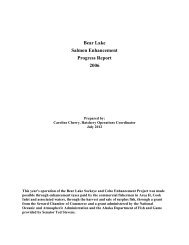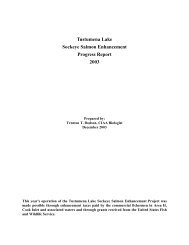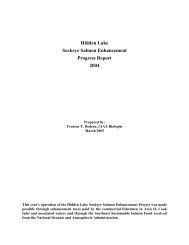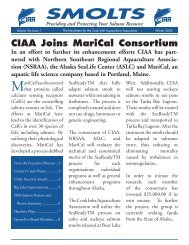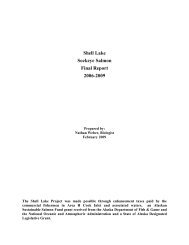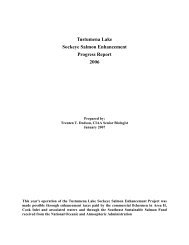Volume 25 Issue 1 - Cook Inlet Aquaculture Association, Kenai, Alaska
Volume 25 Issue 1 - Cook Inlet Aquaculture Association, Kenai, Alaska
Volume 25 Issue 1 - Cook Inlet Aquaculture Association, Kenai, Alaska
Create successful ePaper yourself
Turn your PDF publications into a flip-book with our unique Google optimized e-Paper software.
SPRING/SUMMER 2007<br />
Page 3<br />
Family Tracking Coho Salmon - Mark Thomas, TLH Assistant Manager<br />
Coho salmon fingerlings of Bear Lake stock being reared at Trail Lakes Hatchery in the winter of 2005 and<br />
at Eklutna Hatchery in the subsequent winter of 2006 were diagnosed with Bacterial Kidney Disease<br />
(BKD). For the health of this stock and the programs it supports, it became necessary to screen out the<br />
cause of this problem. Family Tracking provides a practical tool to screen out BKD.<br />
The term ‘Family Tracking’ brings up thoughts of genealogy charts. However, in this application, it only<br />
relates to tracking the progeny of individual fish for one generation in order to screen out pathogens from<br />
entering the hatchery environment. The pathogen being screened in this case is a bacterium called Renibacterium<br />
salmoninarum. It is the causative agent of BKD. This bacterium is endemic to the Pacific Northwest<br />
and exists in numerous wild populations of fish. One route the bacterium is transmitted is within the egg<br />
from parent fish to progeny. It is at this stage that tracking eggs of individual fish that are proven to carry<br />
the pathogen can be screened out and discarded.<br />
In order to carry out this process it was necessary to purchase a different style of incubator. Vertical incubators<br />
(Heath trays) were purchased with capital improvement funds. Though in the experience of Trail<br />
Lakes Hatchery staff, Heath tray incubators do not lend themselves to large scale production, they do an<br />
excellent job of keeping eggs separate for tracking purposes.<br />
At Trail Lakes Hatchery, Family Tracking entails these steps: Preparations are made to coordinate tracking<br />
of eggs from individual spawners through a period of incubation. This involves having corresponding numbering<br />
of fish tags, spawning buckets, kidney<br />
sample containers and incubator trays. For our<br />
purposes, the pooling of three females with two<br />
males is considered an acceptable loss if and<br />
when discarding is necessary. At egg take, each<br />
individual brood fish is tagged with a tracking<br />
number. Eggs from three females and milt from<br />
two males are placed into the spawning bucket<br />
having the corresponding fish tag numbers. The<br />
spawning bucket is also numbered to correlate<br />
with an incubation tray. After the fish are<br />
spawned kidney samples are taken and placed<br />
into sample containers having the fish’s corresponding<br />
number. At the end of the egg take, the<br />
kidney samples are sent to the <strong>Alaska</strong> Department<br />
of Fish and Game Fish Pathology Laboratory to<br />
test for Renibacterium. While waiting for the test<br />
results the eggs are incubated in Heath trays having<br />
the tracking numbers on them. When the test<br />
results are obtained, progeny (in the egg life<br />
stage) with positive parents are discarded, effectively<br />
screening out BKD.<br />
Assistant Hatchery Manager, Mark Thomas inspects<br />
the Heath trays at Trail Lakes Hatchery.<br />
For brood year 2006, two hundred sixty three<br />
fish were sampled. One fish tested positive for<br />
BKD. The incubator tray containing the progeny<br />
of this fish was discarded.<br />
SMOLTS<br />
3



